Papers by Heather Kempton
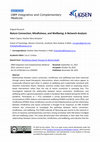
OBM Integrative and Complementary Medicine
Relationships between nature connection, mindfulness and wellbeing have been observed through nat... more Relationships between nature connection, mindfulness and wellbeing have been observed through nature based therapeutic interventions, where mindfulness and nature appear to reciprocally influence each other in relation to wellbeing and is potentially consistent with attention restoration theory. However, previous studies have relied on examining nature based interventions rather than the role of nature connection in everyday lives. This investigation explored the relationship between nature connection, mindfulness, and wellbeing within a general population sample in Auckland, New Zealand during the COVID-19 pandemic. Participants (n = 472) completed a survey questionnaire measuring nature connectedness (CNS), hedonic and eudemonic wellbeing (PANAS and MLQ), stress (PSS), and mindfulness (FFMQ). Given mindfulness consists of interrelated practices and the relationship between mindfulness and nature connection is thought to be reciprocal, an EBIC GLASSO network was constructed to inve...
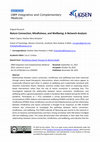
OBM: Integrative and Complimentary Medicine , 2023
Relationships between nature connection, mindfulness and wellbeing have been observed through nat... more Relationships between nature connection, mindfulness and wellbeing have been observed through nature based therapeutic interventions, where mindfulness and nature appear to reciprocally influence each other in relation to wellbeing and is potentially consistent with attention restoration theory. However, previous studies have relied on examining nature based interventions rather than the role of nature connection in everyday lives. This investigation explored the relationship between nature connection, mindfulness, and wellbeing within a general population sample in Auckland, New Zealand during the COVID-19 pandemic. Participants (n = 472) completed a survey questionnaire measuring nature connectedness (CNS), hedonic and eudemonic wellbeing (PANAS and MLQ), stress (PSS), and mindfulness (FFMQ). Given mindfulness consists of interrelated practices and the relationship between mindfulness and nature connection is thought to be reciprocal, an EBIC GLASSO network was constructed to investigate the pathways between nature connection, mindfulness, and wellbeing. The FFMQ subscale of Observing was central to the network in terms of closeness and betweenness and had a strong correlation with CNS where it bridged CNS and wellbeing scales. This study demonstrates that individuals in their daily lives show relationships between nature connection, mindfulness, and wellbeing, and indicates that the
Counselling and Psychotherapy Research , 2022
Well-being benefits of mindfulness-based programmes (MBPs) have an increasingly solid foundation ... more Well-being benefits of mindfulness-based programmes (MBPs) have an increasingly solid foundation of evidence in the research literature; where once there was a lack of randomised control trials (RCTs), there are now a growing number of RCTs as well as systematic reviews and meta-analyses (
The existing literature broadly accepts that affective states are able to influence the way we pr... more The existing literature broadly accepts that affective states are able to influence the way we process our complex environment. Many theories have been developed to explain the relationship between mood and processing strategy in compound stimuli. A common theme in some of these theories is that there is a pre-set and fixed link between a particular mood valence and visual perception strategies (e.g.
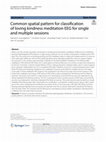
Brain Informatics, 2023
While a very few studies have been conducted on classifying loving kindness meditation (LKM) and ... more While a very few studies have been conducted on classifying loving kindness meditation (LKM) and non-meditation electroencephalography (EEG) data for a single session, there are no such studies conducted for multiple session EEG data. Thus, this study aims at classifying existing raw EEG meditation data on single and multiple sessions to come up with meaningful inferences which will be highly beneficial when developing algorithms that can support meditation practices. In this analysis, data have been collected on Pre-Resting (before-meditation), Post-Resting (aftermeditation), LKM-Self and LKM-Others for 32 participants and hence allowing us to conduct six pairwise comparisons for the four mind tasks. Common Spatial Patterns (CSP) is a feature extraction method widely used in motor imaginary brain computer interface (BCI), but not in meditation EEG data. Therefore, using CSP in extracting features from meditation EEG data and classifying meditation/non-meditation instances, particularly for multiple sessions will create a new path in future meditation EEG research. The classification was done using Linear Discriminant Analysis (LDA) where both meditation techniques (LKM-Self and LKM-Others) were compared with Pre-Resting and Post-Resting instances. The results show that for a single session of 32 participants, around 99.5% accuracy was obtained for classifying meditation/Pre-Resting instances. For the 15 participants when using five sessions of EEG data, around 83.6% accuracy was obtained for classifying meditation/Pre-Resting instances. The results demonstrate the ability to classify meditation/Pre-Resting data. Most importantly, this classification is possible for multiple session data as well. In addition to this, when comparing the classification accuracies of the six mind task pairs; LKM-Self, LKM-Others and Post-Resting produced relatively lower accuracies among them than the accuracies obtained for classifying Pre-Resting with the other three. This indicates that Pre-Resting has some features giving a better classification indicating that it is different from the other three mind tasks.
Applied Cognitive Psychology, 2015
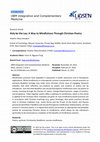
OBM Integrative and Complementary Medicine, 2021
Mindfulness practices have exploded in popularity in public awareness and in therapeutic applicat... more Mindfulness practices have exploded in popularity in public awareness and in therapeutic applications. While mindfulness in a therapeutic context is presented as a secular practice, its primarily Buddhist heritage may make some Christian clients wary of engaging. Research indicates that both reflection (co-creation) on poetry and creation of poetry can be therapeutic, and that both Buddhist and secular/therapeutic mindfulness texts use poetry to convey meaning through key themes of nature, change/impermanence, stages of practice, and acceptance. Taken together poetry offers a pathway to mindfulness, which in this article is applied to the Christian client. Examples are given of: how mindfulness-based practices are in accordance with Christian teachings (e.g., grace theology), that poetic practices already exist in Christian traditions (e.g., Lectio Divina and the Prayer of the Heart), and themes previously identified in Buddhist and secular/therapeutic mindfulness related poetry, ar...
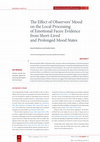
Advances in cognitive psychology / University of Finance and Management in Warsaw, 2015
We examined the effect of induced mood, varying in valence and longevity, on local processing of ... more We examined the effect of induced mood, varying in valence and longevity, on local processing of emotional faces. It was found that negative facial expression conveyed by the global level of the face interferes with efficient processing of the local features. The results also showed that the duration of involvement with a mood influenced the local processing. We observed that attending to the local level of faces is not different in short-lived happy and sad mood states. However, as the mood state is experienced for a longer period, local processing was impaired in happy mood compared to sad mood. Taken together, we concluded that both facial expressions and affective states influence processing of the local parts of faces. Moreover, we suggest that mediating factors like the duration of involvement with the mood play a role in the interrelation between mood, attention, and perception.

The construct of “mindfulness” has increasingly become a focus of research related to meditation ... more The construct of “mindfulness” has increasingly become a focus of research related to meditation practices and techniques. As a result, there is a growing body of research indicating clinical efficacy from therapeutic use, while cognitive neuroscience has provided an insight into the brain regions and mechanisms involved. Significantly, these approaches converge to suggest that attention is an important mechanism with sub-components of attention being trainable. This article discusses the role of attention; as well as arguing that memory has been neglected as a potentially key mechanism in meditation/mindfulness practices. Specifically, it is proposed that working memory offers a useful model for integrating and understanding the different mental devices that are used in meditation, with the potential to provide a comprehensive account of how the apparent benefits of these practices arise. This call for a more comprehensive and integrated approach is necessary if the study and application of meditation is to become more than a parochial concern.
Teams are not necessarily the same psychological entity as groups, yet the assessment question, “... more Teams are not necessarily the same psychological entity as groups, yet the assessment question, “Are you a team player?” is heavily clichéd and prone to faking. We report a triangulation of methods assessing prepar-edness for teamwork, based on prototype theory, the priming paradigm, and signal detection theory. Groups prototypically lack cohesion, involve working as individuals, and are based on similarity. Teams, however, work towards a common goal and build on interpersonal relationships. Reaction times suggest groups have underlying schemata whereas teams often do not. Signal Detection analysis shows team characteristics are applicable to groups, but not vice-versa – team is a subtype of group. Discussion focuses on team design and the importance of selecting indi-viduals with well-developed schemata for teams rather than groups.
Reflective Practice, 2013
ABSTRACT Reflective practices are an important aspect of qualitative research. They allow the res... more ABSTRACT Reflective practices are an important aspect of qualitative research. They allow the researcher to assess their feelings, attitudes and potential biases to their subject matter, which often includes interviews with participants. However, reflective practices are not typically associated with the more quantitative aspects of social science. This paper, through personal illustration, aims to show how reflective practices can lead to open and inquisitive questioning for those who work with empirically derived data. As a cognitive psychologist, I reflect here on my experience of meditation, and my recognition of different modes of thinking, and conclude by aspiring to find a balance between the rational and the intuitive.

Mindfulness, 2020
Objectives Despite mindfulness-based programs (MBPs) being presented and practiced in a secular c... more Objectives Despite mindfulness-based programs (MBPs) being presented and practiced in a secular context, the traditions they have drawn from are spiritually based (e.g., Buddhist). Starting with a critical discussion of the secular/spiritual nature of mindfulness practices, the objective was to show how the divide between the two might be bridged with the skillful use of poetry as an active form of meaning-making (spirituality). Methods The inspired poetry of meditation, contemplation, and introspection in Buddhist traditions was reviewed, indicating that spiritual aesthetics have an important place in encouraging mindful practices that might also be useful to secular MBPs. The type of poetry found in MBP handbooks/manuals, and the context in which they were used, was surveyed and then contrasted with these traditional forms. Results Poetry themes overlapped with contemplative poetry from Buddhist traditions, with nature and change (as paradox) being frequently employed. Where the poetry in secular mindfulness texts differed was (1) in a lack of differentiating stages or paths, (2) in being simple and direct rather than abstract, and (3) focusing on acceptance. Conclusions Suggestions are made as to how poetry may be applied in mindfulness practices, with potential benefits of using them to address spiritual issues, including mitigating adverse effects and supporting religious backgrounds, as well as offering an active, reflexive, meaning-making activity for practitioners, instructors, and researchers that in itself could be used as a research tool.
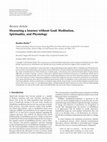
Copyright © 2015 Heather Buttle.This is an open access article distributed under theCreativeCommo... more Copyright © 2015 Heather Buttle.This is an open access article distributed under theCreativeCommonsAttribution License, which permits unrestricted use, distribution, and reproduction in any medium, provided the original work is properly cited. The secular practice of meditation is associated with a range of physiological and cognitive effects, including lower blood pressure, lower cortisol, cortical thickening, and activation of areas of the brain associatedwith attention and emotion regulation.However, in the context of spiritual practice, these benefits are secondary gains, as the primary aim is spiritual transformation. Despite obvious difficulties in trying to measure a journey without goal, spiritual aspects involved in the practice of meditation should also be addressed by experimental study.This review starts by consideringmeditation in the form of the relaxation response (a counterpart to the stress response), before contrasting mindfulness research that emphasizes the role ...
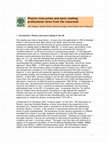
Debates about the most effective ways of teaching early readers have raged for more than half a c... more Debates about the most effective ways of teaching early readers have raged for more than half a century. In recent years, government in the UK and in some other English-speaking countries has promoted the teaching of “synthetic phonics” as the key to success in training young readers. Schools were offered government funding to buy approved materials and a new, statutory phonics screening 'check' for all children in Year 1 was introduced. This check was widely criticised, and the governmental instruction to use synthetic phonics as the core reading method met considerable opposition from the profession. To discern the reasons for these concerns, and their validity, the UK National Association for the Teaching of English conducted an on-line survey of teachers' views and practices in relation to the teaching and assessment of early reading. 445 respondents completed the survey. They were asked what weight they placed on phonics when assessing overall reading levels; whethe...
Road & Transport Research, 2015
Media messages for educating drivers tend to be short and simple (e.g. 'Speed kills'), bu... more Media messages for educating drivers tend to be short and simple (e.g. 'Speed kills'), but the actual act of driving is a complex cognitive task that places demands on drivers' attentional resources. This study uses thematic analysis of online news discussion to examine understandings of driving issues related to speed enforcement. Using five discussions from the 'New Zealand Herald', several themes emerged that revealed complex concerns, which included the political and the cognitive. The complex cognitions and motive questioning observed in these responses offer a number of considerations for the future direction of road safety management in New Zealand and elsewhere.

This study aimed to explore attitudinal differences between young and older New Zealand adults to... more This study aimed to explore attitudinal differences between young and older New Zealand adults to seeking professional mental health services, including effects of previous help, and the types of service preferred. A questionnaire which included the Inventory of Attitudes towards Seeking Mental Health Services (IASMHS), together with questions regarding previous help, and preferred services for mental health needs, was administered to 125 participants aged 27-91 residing in the north Auckland area. Older adults were higher in help-seeking propensity (HSP) but less psychologically open (PO) than their younger counterparts. In older adults only, previous help contributed positively towards PO, while increased satisfaction with previous help correlated with increased indifference to stigma (IS). Older adults had a preference for physicians for mental health issues, followed by friends, God, clergy and psychiatrists. Attitudes towards help-seeking were generally favourable in older adul...
Journal of Consumer Affairs

ObjectiveBy committing to latent variable models, mindfulness research has aimed to transform obs... more ObjectiveBy committing to latent variable models, mindfulness research has aimed to transform observable practices into an identifiable real ‘mindfulness’ experience which is claimed to exist beyond what is directly observed. Recently, an alternative methodology has been developed which allows mindfulness to be modelled as a complex system or network at the level of self-report. This study hypothesised that a more densely connected network of observable practices is indicative of a greater level of development of mindfulness. MethodsMindfulness networks were estimated for practitioners and non-practitioners using the Friedberg Mindfulness Inventory (FMI). A total of 371 regular mindfulness practitioners, 224 non-practitioners and 59 irregular practitioners were recruited online from the Amazon Mechanical Turk database. ResultsComparisons of practitioners’ and non-practitioners’ networks indicated that network density did not significantly differ, whereas evidence was found in suppor...
RMIT Training Pty Ltd (ACN 006 067 349) of Kay House, Level 3, 449 Swanston Street, Melbourne, Vi... more RMIT Training Pty Ltd (ACN 006 067 349) of Kay House, Level 3, 449 Swanston Street, Melbourne, Victoria, trading as RMIT Publishing (the Publisher) grants you, the User, access to the text of the selected and purchased copyright works included in the INFORMIT PAY-...











Uploads
Papers by Heather Kempton